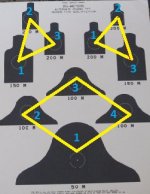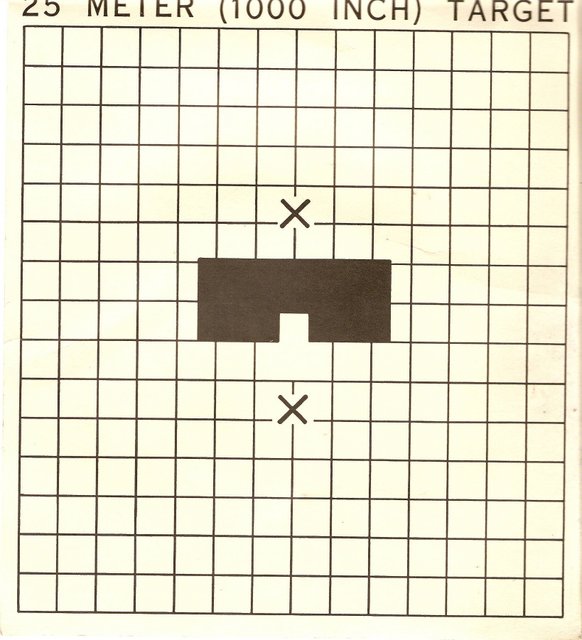First off, you have to decide if you want to play the games the army plays or do you want to learn to shoot, and fire expert scores.
That will determine how you should practice and and zero.
You have to understand that range personnel in Army Basic training, are Drill instructors, not Marksmanship Instructors. There is a heck a a lot of difference.
I've shot a lot, I've coached National Guard Rifle teams and was in charge of the Marksmanship Training (qualifications and competitions) for the Alaska National Guard for years.
I teach the old method of zeroing and qualification. Meaning I used the old Canadian bull. When used properly, you'll end up sighting your rifle in for 250 yards which will allow you to shoot center mass of all the targets from 50 to 300 yards (they use meters but its the same thing).
For the M16 you aim at the bottom of the black center, (6 O'Clock hold), adjust your sights where, using this aiming point, the group is at the top "X".
Practice this from the prone unsupported, (hasty sling). and from the prone sandbag position. Concentrate on your fundamentals, concentrate on your front sight and trigger control. Make sure the front sight is clear and sharp.
Now the DI may or may not tell you "this and that" "do this, do that, you're doing it wrong" etc etc,". DO NOT ARGUE WITH THE DI, simply say "yes drill Sargent" then go back to following my instructions.
I have taught a heck of a lot of new soldiers this method, and when they got to basic, none has ever failed to shoot Expert.
To see what I mean, put the ballistics of the M16 and the issued ammo in a ballistic program, set the zero in the program for 250 yards, and look at the drop chart to 300 yards. You'll see its never 4 inches high or 4 inches low all the way to 300 yards. Understand that the longer distance targets (100-300) yard (meter) targets are the E-Silhouette targets which are 19 X 40 inches. Aim center mass and you have lots of room to play with.
As a side not, The Army Marksmanship Unit Sniper School for Civilian LE they recommended the 223 round in a bolt gun. They teach the same method pointing out, that with a 250 zero you can make head shots to 300 yards without sight adjustments or hold over/under. It works. I used this zero on the Rifle I carried in the Counter/Sniper roll and its the same procedure I taught when teaching the rifle in to our SWAT teams.
Using the Canadian Bull, take a 6 O'Clock hold on the bull, practice until you get your three shot groups the size of the squares, centered on the top "X". The rest is up to you, FRONT SIGHT, FRONT SIGHT, FRONT SIGHT.
That is critical. I like to teach people to think of the front sight being on a lever with the trigger. As you pull the trigger (squeeze) you are actually sliding the front sight to the rear of the rifle.
Now we all know that you're not moving the front sight, but if you concentrate on squeezing the trigger in an effort to move the front sight, it will seem like you are actually pulling it back to your eye. Its not of course, but it looks like it is simply because you are concentrating on the front sight and it get clearer and sharper, which makes it look closer.
If you do the above, you'll shoot expert, I don't mean qualifying, I mean shoot expert.
Below is the Canadian bull, but if you pm me with your e-mail address, I'll send you the actual size on .pdf format that you can print out and use.
Remember, practice from the prone unsupported (with hasty sling) and off sand bags. I cannot stress enough the points of FRONT SIGHT & SMOOTH TRIGGER CONTROL.


